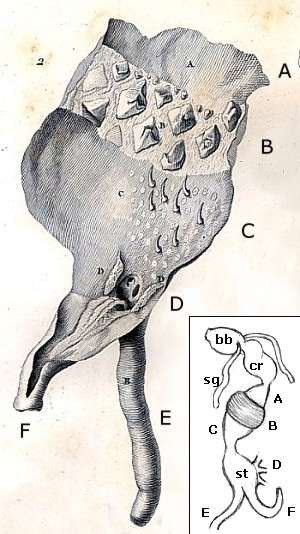'Teeth' in the gut of Bursatella
March 10, 2000
From: Jack Rudloe
Dear Dr. Rudman:
Do you have any information on the "teeth" in the crop of Bursatella and Aplysia? There's an orange crop, or stomach that has a dozen or so triangular teeth-like structures that appear to be made out of some unusual transluscent yellow or green material that I find intriguing. This year in the northeastern Gulf of Mexico, we've got swarms of Bursatella washing up on the beaches, and I was wondering if anyone ever looked at the "teeth" for some unique bio-material. Any information will be appreciated, and thanks for having your slug website. See ours at www.Gulfspecimen.org
Thanks,
Jack Rudloe,
President
gspecimen@sprintmail.com
Rudloe, J., 2000 (Mar 10) 'Teeth' in the gut of Bursatella. [Message in] Sea Slug Forum. Australian Museum, Sydney. Available from http://www.seaslugforum.net/find/2068
Dear Jack,
The gut of the sea hares follows a very similar design throughout the Order. I have used a very old drawing of Cuvier's (1803) of the opened gizzard region to illustrate the arrangement [mainly because most people don't get a chance to see these old figures]. The inset is a sketch of mine to show the whole gut. In Cuvier's drawing many of the hooks in the filter chamber (C) are missing. They should form a dense band right around the chamber.
There is a muscular buccal bulb (bb), opening at the mouth, and it contains the broad rasping radular ribbon used to break off pieces of the algae it feeds. A pair of long salivary glands (sg) open into it. the oesophagus is a large extensible sac or crop (cr) in which pieces of algal food are stored before being crushed in the gizzard, which is broken into 3 regions (ABC). The first (A) is unarmed and presumably is just an anterior holding sac for partially digested food forced down from the crop. The second part of the gizzard (B) has a basal layer of circular muscle encircling the gizzard, and is lined with large chitinous pyramidal crushing plates which reduce the algal plates to fine pieces and a slurry of algal 'juice'. The third region (C) is lined with find recurved chitinous hooks which filter the crushed slurry of food, preventing large particles from moving further down the gut.
The stomach (st) is a very small chamber into which the ducts (D) of the digestive gland open. Also opening into the stomach are the caecum (F) and the intestine (E). Then stomach and caecum are lined with ciliated ridges and there is obviously a very complicated sorting process going on in the stomach, separating edible and inedible particles from the gizzard, and faecal and excretory products from the digestive gland. The caecum seems to be where the faecal pellets are formed.
This is probably more than you wanted to know. Suffice to say that the gizzard plates are of two sorts. A band of large crushing plates and then a region of relatively fine hooks packed close together to form a filter chamber.
Best wishes,
Bill Rudman.
Best wishes,
Bill Rudman.
Related messages
-
Aplysia from Bay of Bengal
From: Rajesh Kumar, May 5, 2010 -
Re: Food of Aplysia from Hawaii
From: Kate Werner, January 13, 2009 -
Re: Food of Aplysia from Hawaii
From: Kate Werner, January 12, 2009 -
Re: Aplysia brasiliana from Texas, Gulf of Mexico
From: Georgia Doyle, October 9, 2008 -
Strange phenomenon with Sea Hare
From: Ute Duvenhage, February 19, 2008 -
Re: Sea hare being eaten by crab - Reunion Is.
From: Hugues Flodrops, February 9, 2008 -
Re: Slugs of my childhood - Baja California
From: Jeff Goddard, November 10, 2005 -
Slugs of my childhood - Baja California
From: Alicia Sarun, November 9, 2005 -
Why are they called Sea Hares?
From: Bill Rudman, May 14, 2005 -
Dangerous to dogs, yes, but what about to people?
From: John Vincent, April 13, 2005 -
Unknown worm mass
From: Rick Eastwood, February 10, 2004 -
Sea Hares - strange behaviour.
From: Krista Recsei, January 12, 2004 -
Aplysia in Thailand
From: Dunyaporn Trachootham, December 1, 2003 -
Re: Sea Hares and Red Tides
From: Josh Anderson, November 20, 2003 -
Sea Hares & Red Tides
From: Josh Anderson, November 19, 2003 -
Re: Sea Hare from Hawaii
From: Dee Wamock, October 8, 2003 -
Sea Hare eggs
From: Angie Jones, September 12, 2003 -
Sea Hare from Hawaii
From: Dee Wamock, August 25, 2003 -
Are Sea Hares in Mexico edible?
From: Pepe Herrera, August 11, 2003 -
Sea Hares [Aplysia] in Channel Ids
From: Stephen R Hoskins, February 18, 2002 -
Genetic phylogeny of Aplysia in the UK
From: Stephen Hoskings, February 8, 2002 -
Genetic Studies of Sea Slugs
From: Eric Diano, March 26, 2001 -
Information about Sea Hares
From: Ray and Danny, March 12, 2001 -
Overview of Aplysia reproduction
From: Moira Rankin, December 30, 2000 -
Sea Hares & egg laying
From: L. Rivard, October 17, 2000 -
Participant information
From: Sara Black, October 5, 2000 -
Where can I find an Aplysia book?
From: Suzanne Grosso-Mennecke, September 29, 2000 -
Sea Hares and Tide Pools
From: Will Akers, September 24, 2000 -
More Sea Slug Hitchhikers
From: Andrew Trevor-Jones, September 23, 2000 -
I need information on Sea Hares
From: Chantelle, July 13, 2000 -
Learning in Aplysia
From: Raphaël Favre, June 29, 2000 -
Swimming Aplysia from Philippines
From: Erwin Koehler, June 24, 2000 -
Galapagos Sea Hare
From: Mark Blum, June 19, 2000 -
Sea Hares from the Red Sea
From: Alaa youssry Moustafa, May 25, 2000 -
Aplysia Osmoregulation
From: Myrtle, February 25, 2000 -
Aplysia from Japan
From: Yasuhiro Shirai, February 17, 2000 -
Anatomy of Aplysia
From: Sylvia E. Jones, January 28, 2000 -
What is this?
From: FAbienne Bovis, January 3, 2000 -
Sea Hare information
From: alexis, November 13, 1999 -
Where in Europe is Aplysia available ?
From: Ulrich Storz, November 7, 1999
